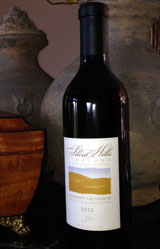SHV’s first vintage was in 2004, and we have made wine every year since, except 2011. All SHV wines like to get 20-30 minutes of air after opening the bottle; decant or just pour in the glass to let it open.
Clone 4
Cabernet Sauvignon FPS 04 came to UC Davis in 1964 with USDA-ARS P.I. number 296424. The selection arrived with the erroneous label “Merlot”, clone 11. The selection was later properly identified and appeared for the first time on the list of registered vines in 1966.
Generally, plant material began to move from Europe to the Americas in the 16th century, when commercial vineyards were first established in Mendoza, Argentina’s most important wine-growing province. (Robinson, 2006). Two Cabernet Sauvignon selections – Cabernet Sauvignon FPS 04 and 05 – were imported to Davis in 1964 from Mendoza. According to Susan Nelson-Kluk, FPMS Manager at the time, Austin Goheen arranged the importation because he believed that grape plant material obtained from South America was less likely to be infected with phylloxera. (Nelson-Kluk, 2008). Cabernet Sauvignon FPS 04 and 05 arrived labelled incorrectly as “Merlot clones 11 and 12”. No treatment was required for either selection. They were later properly identified and appeared for the first time in 1966 on the list of registered vines in the California Grapevine Registration & Certification (R & C) Program.
Clone 4 is a moderate producer with strong flavor intensity. The clone has very good color, aromas and palate balance, with little herbal character and some spiciness. Common aroma descriptors include blackberry, cooked prunes, tar, tobacco. Common taste descriptors are cassis and spice.
Wineries currently releasing wines deploying Cab clone 4 include Beaulieu, Tor ToKalon, Schrader, and Cyrus Creek.
Rootstock 101-14
Millardet et De Grasset parentage V. riparia x V. rupestris; high vigor; high phylloxera resistance; moderate root-knot resistance; heavy clay soil preference; low/moderate drought resistance; high wet feet tolerance; 9% active lime resistance; very low salt resistance; early influence maturity; more rigorous than Riperia Gloire, advances maturities of late varieties.










